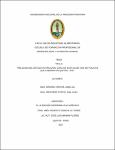| dc.contributor.advisor | Alva Arévalo, Alenguer Gerónimo | |
| dc.contributor.advisor | Concha La Torre, Ernesto | |
| dc.contributor.advisor | Mamani Flores, José Luis | |
| dc.contributor.author | Macedo Chávez, Jorge Luis | |
| dc.contributor.author | Meléndez García, Rajiv André | |
| dc.date.accessioned | 2018-06-08T15:04:27Z | |
| dc.date.available | 2018-06-08T15:04:27Z | |
| dc.date.issued | 2017 | |
| dc.identifier.uri | http://repositorio.unapiquitos.edu.pe/handle/20.500.12737/5396 | |
| dc.description.abstract | El presente proyecto se desarrolló con el objetivo de determinar el efecto de los Estilos de vida en relación al Estado Nutricional en Policías que laboran en la ciudad de Iquitos atendidos en el consultorio interno del Policlínico PNP, durante el año 2017. La investigación fue de enfoque cuantitativo, no experimental, descriptivo correlacional, trasversal y analítica. La muestra estuvo constituida por 459 policías que acudieron al Consultorio Interno de la PNP. En la recolección de datos se empleó los siguientes instrumentos: Balanza calibrada, Tallímetro, Tablas de Valoración Nutricional (CENAM), Cuestionario de Perfil de Estilos de Vida. Los resultados fueron: Respecto a los Estilos de Vida de 459 policías entrevistados durante el año 2017, un 12 % (55) cuentan con un estilo de vida Saludable en comparación con el 59,5 % (273) con un estilo de vida no saludable. En cuanto al Índice de Masa Corporal (IMC), 22,7% (104) presentaron Estado Nutricional Normal, 51,9% (238) se encontraron en Sobrepeso, 23,3% (107) presentaron obesidad y 2,2% (10) obesidad tipo mórbida. Al análisis de los Estilos de Vida con el Estado Nutricional se obtuvo que 104 (22,7%) policías de estado nutricional normal, el 11,3% (53) tienen estilos de vida saludable y el 6,3% (29) estilos de vida no saludable. De 238 (51,9%) policías con sobrepeso, 34,9% (160) tienen estilo de vida no saludable y solo 0,4 % (27) estilos de vida saludable. Finalmente, de 107 (23,3%) policías con obesidad, 16,3% (75) presentan estilos de vida no saludable y solamente 0,2% (1) estilos de vida saludable. De los 10 (2,1%) policías con obesidad mórbida, 2,0%(9) tienen estilos de vida no saludable y el 0,2% (1) estilo de vida poco saludable, no hubo policía con estilos de vida saludable. Del análisis de la relación entre los estilos de vida y el estado nutricional, utilizando la prueba estadística no paramétrica para variables categóricas ordinales τb de Kendall, se concluye que existe relación estadística altamente significativa (p < 0,01) entre ambas variables con valor de significancia bilateral p=0,0000000000000001543. | es_PE |
| dc.description.abstract | The present project was developed with the objective of determining the effect of the Lifestyles in relation to the Nutritional State in Police that work in the city of Iquitos attended in the internal clinic of the PNP Polyclinic, during the year 2017. The research was focused quantitative, not experimental, descriptive correlational, transversal and analytical. The sample consisted of 459 police officers who went to the Internal Office of the PNP. In the data collection the following instruments were used: Calibrated balance, Height Meter, Nutritional Assessment Tables (CENAM), Lifestyles Profile Questionnaire. The results were: With respect to the Lifestyles of 459 policemen interviewed during the year 2017, 12% (55) have a Healthy lifestyle compared to 59.5% (273) with an unhealthy lifestyle . Regarding the Body Mass Index (BMI), 22.7% (104) presented Normal Nutritional Status, 51.9% (238) were found in Overweight, 23.3% (107) presented obesity and 2.2% ( 10) Morbid type obesity. The analysis of the Lifestyles with the Nutritional State showed that 104 (22.7%) police of normal nutritional status, 11.3% (53) have healthy lifestyles and 6.3% (29) styles of unhealthy life. Of 238 (51.9%) overweight police officers, 34.9% (160) have unhealthy lifestyle and only 0.4% (27) healthy lifestyles. Finally 107 (23.3%) police with obesity, 16.3% (75) have unhealthy lifestyles and only 0.2% (1) healthy lifestyles. Of the 10 (2.1%) police with morbid obesity, 2.0% (9) have unhealthy lifestyles and 0.2% (1) unhealthy lifestyle, there was no police with healthy lifestyles . From the analysis of the relationship between lifestyles and nutritional status, using the nonparametric statistical test for categorical ordinal variables τb of Kendall, it is concluded that there is a highly significant statistical relationship (p <0.01) between both variables with a value of bilateral significance p = 0.0000000000000001543. | en_US |
| dc.description.uri | Tesis | es_PE |
| dc.format | application/pdf | es_PE |
| dc.language.iso | spa | es_PE |
| dc.publisher | Universidad de la Amazonía Peruana | es_PE |
| dc.rights | info:eu-repo/semantics/openAccess | es_PE |
| dc.rights | Attribution-NonCommercial-NoDerivs 3.0 United States | * |
| dc.rights.uri | http://creativecommons.org/licenses/by-nc-nd/3.0/us/ | * |
| dc.source | Universidad Nacional de la Amazonía Peruana | es_PE |
| dc.source | Repositorio institucional - UNAP | es_PE |
| dc.subject | Estado nutricional | es_PE |
| dc.subject | Policía | es_PE |
| dc.subject | Estilo de vida | es_PE |
| dc.title | Relación del estado nutricional con los estilos de vida de policías que laboran en Iquitos - 2017 | es_PE |
| dc.type | info:eu-repo/semantics/bachelorThesis | es_PE |
| thesis.degree.discipline | Bromatología y Nutrición Humana | es_PE |
| thesis.degree.grantor | Universidad Nacional de la Amazonía Peruana. Facultad de Industrias Alimentarias | es_PE |
| thesis.degree.level | Título Profesional | es_PE |
| thesis.degree.name | Licenciado en Bromatología y Nutrición Humana | es_PE |
| thesis.degree.program | Regular | es_PE |
| dc.subject.ocde | http://purl.org/pe-repo/ocde/ford#3.03.04 | es_PE |


